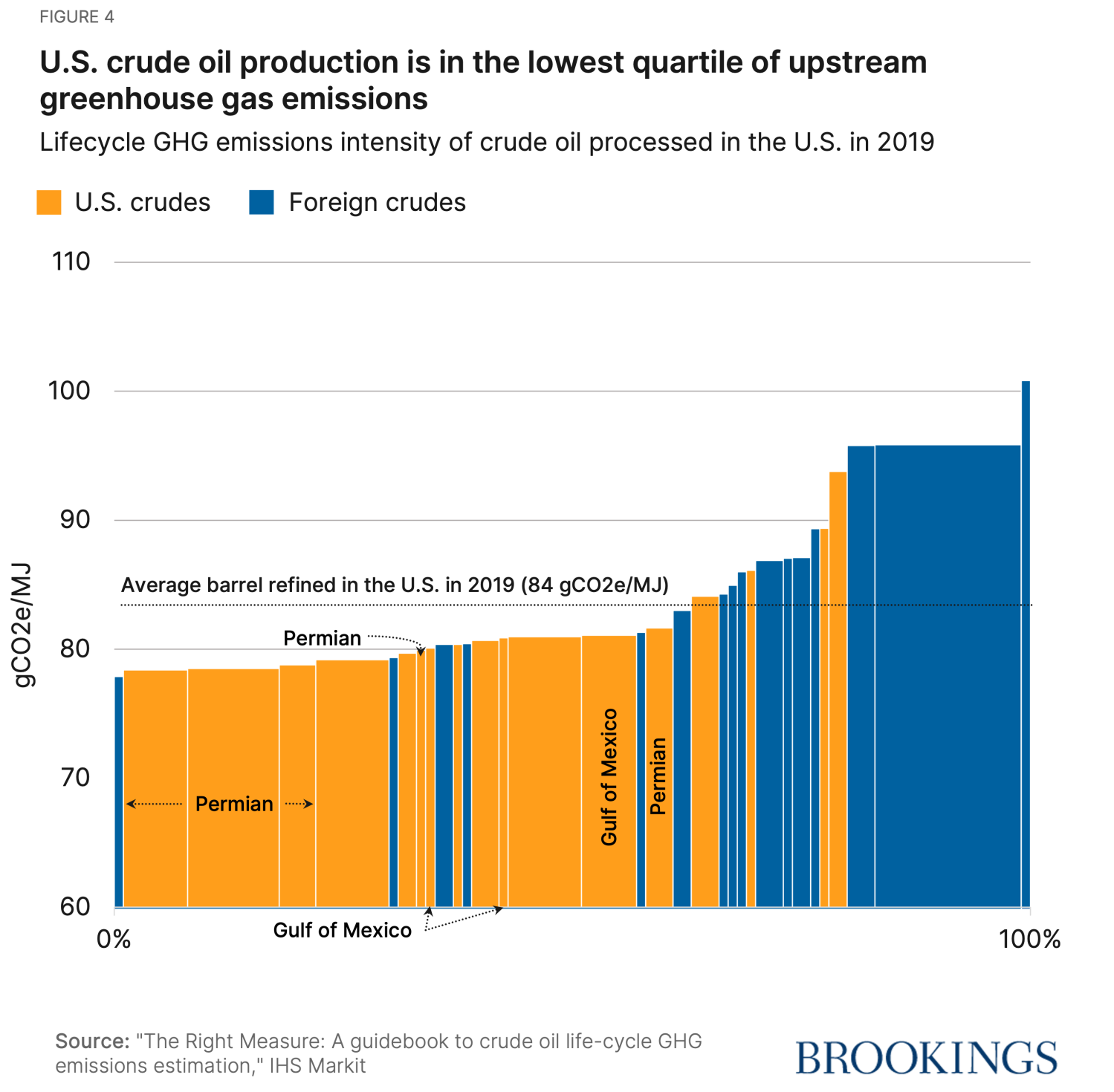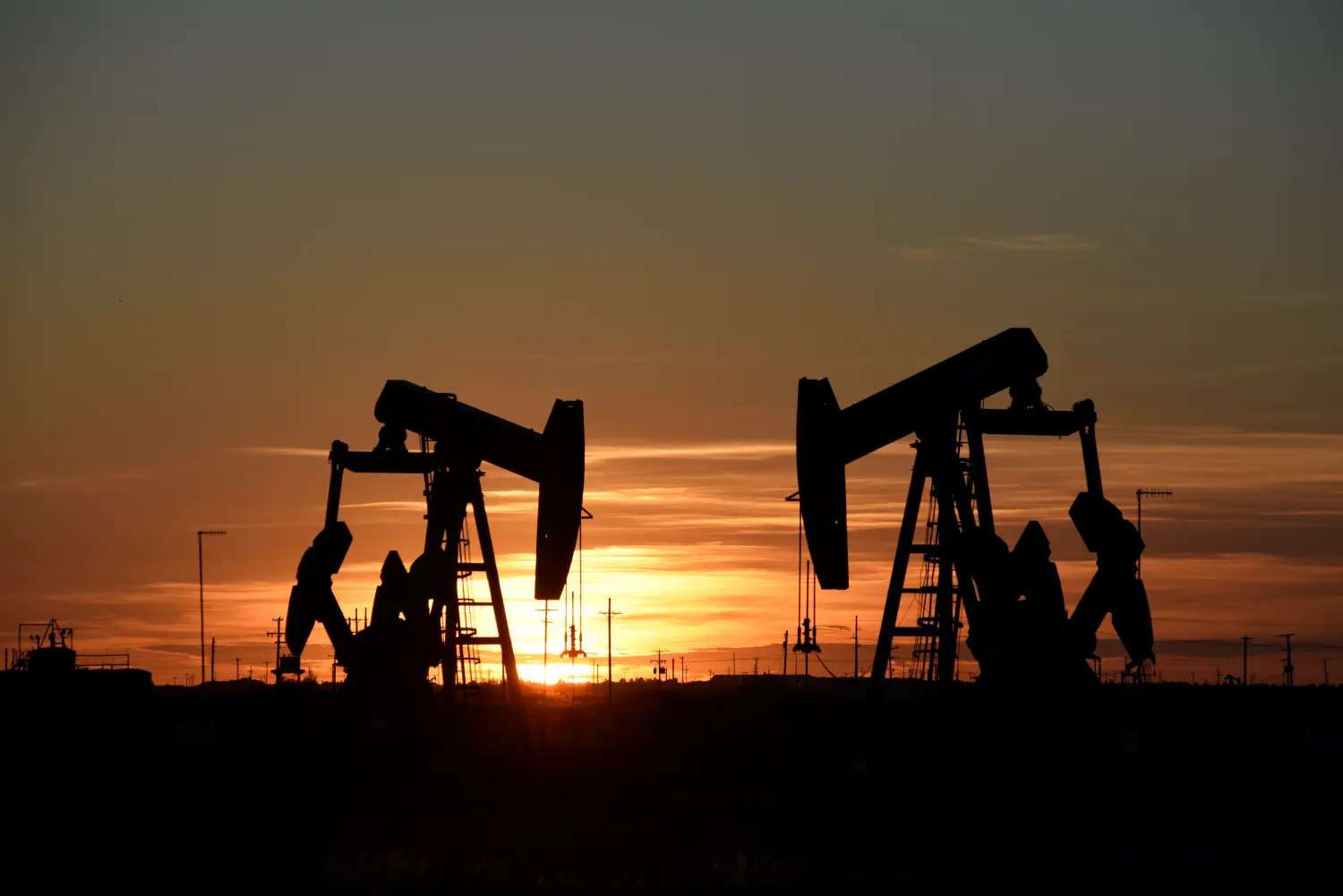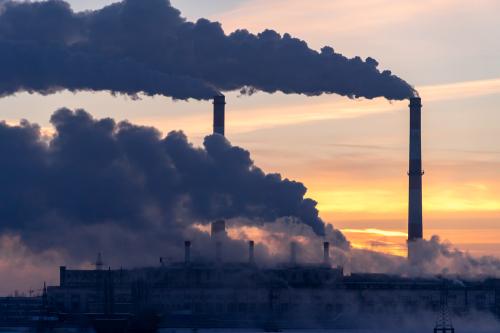United States oil production is a lightning rod for the environmental community. A focus on reducing oil production to combat climate change seems obvious. Without production, oil can’t be consumed. Moreover, much production in the United States comes from oil companies whose past behavior makes them easy targets for attacks. Some companies acted to deny and bury climate science in the past, drawing comparisons to the tobacco industry.1 Many of the large players in the oil industry are household names and are frequently in the news when they generate huge profits.
However, this paper argues that the best way to reduce U.S. greenhouse gas (GHG) emissions from the oil industry is to reduce oil demand, rather than focusing on reducing domestic oil production. This is a more difficult task than protesting particular projects or companies; it involves changing the system through which we use energy. In the case of oil, it primarily involves changing how we fuel our transportation system — moving from gasoline and diesel to electricity for most of our on-road transport. It could also involve redesigning our cities and lifestyles, making more efficient forms of transport workable and attractive. While this task might be more challenging, changing our patterns of fuel demand will actually, permanently decrease U.S. greenhouse gas emissions.
Without these changes in our transport system, canceling specific projects or limiting U.S. oil production will only move emissions elsewhere, rather than reducing them. The United States is not the world’s marginal producer of oil, meaning that eliminating a project in the United States will not meaningfully reduce global oil production. Oil is plentiful, fungible, and easy to transport, and other producers can easily step in to meet oil demand if the United States does not. U.S. energy security will also suffer if the United States reduces domestic oil production faster than demand.
This paper does not argue for unchecked oil production. Continuing production must be accompanied by strong policies to reduce oil demand, as we see today in stringent fuel economy standards established and proposed by the Biden administration, along with strict regulation of domestic oil production. Climate change is a global problem, and policies that simply move emissions outside the United States are not real solutions.
Controversy over continuing oil production and climate goals
The United States under the Biden administration has made ambitious promises of greenhouse emissions reductions, pledging a 50% to 52% reduction of net U.S. emissions by 2030, from a 2005 baseline.2 The Inflation Reduction Act (IRA), passed in August 2022, is a key down payment on that promise. The IRA offers tax credits for many clean energy technologies and funds the research and implementation of promising technologies. Controversially, it also includes a provision requiring the government to offer specified acreage of federal onshore and offshore holdings for oil and gas leasing, in order to allow for onshore and offshore renewables development.3 This provision goes against a promise President Joe Biden made on the campaign trail not to approve new drilling for oil and gas on federal lands and was controversial in the environmental community. Nonetheless, the compromise was necessary to generate enough votes for the bill’s passage, and the benefits of the IRA far outweigh any additional fossil production that might occur.4
Biden’s recent approval of the Willow project, an oil production project on Alaska’s North Slope, attracted a great deal of attention from those concerned about the climate. ConocoPhillips had been acquiring oil and gas leases in the area since the late 1990s and was seeking final approval to drill.5 The administration approved a slimmed-down version of the project in March 2023, granting ConocoPhillips permission to drill on some areas of its leased lands while the company agreed to relinquish its leases in other areas.6 Nonetheless, the Willow project approval brought a new level of backlash, with activists describing the project as a “carbon bomb” incompatible with U.S. climate goals and accusing the administration, which very much wants to keep climate goals at the center of its policies, of hypocrisy.7
Against the backdrop of political drama around this one project, the United States continues to be a leader in oil production. After years of decline, in 2008 U.S. oil production began growing rapidly.8 The combination of two existing technologies, hydraulic fracturing and horizontal drilling, made production possible from oil and gas deposits that had never been “in the money” before. This trend brought about numerous economic benefits, including job creation, improvement in the balance of trade, and greater competitiveness for certain industries. In addition to the growth in oil production, the accompanying natural gas boom brought low prices and a move away from coal and toward gas in power generation, with important reductions in greenhouse gas emissions and local pollution.
After a sharp production drop during the pandemic, U.S. oil production has since grown 30% from its low point in May 2020 and is now roughly what it was before the pandemic.9 In 2022 the United States was the world’s largest oil producer.10
Oil supply can be easily replaced; reducing demand reduces emissions
These seemingly disparate issues come together around one idea. The world needs to transition away from fossil fuels, at least those burned without carbon capture and storage, to avoid the worst impacts of climate change. This is a given, as carbon dioxide produced during fossil fuel use is the driving force behind our changing climate. The need to phase out fossil fuels leads some environmentalists to call for a reduction or elimination of U.S. oil production.
This point of view makes a certain kind of sense. If fossil fuels aren’t produced, they won’t be used. However, the objection to individual oil production projects misses a key reality in today’s world: oil is plentiful. Describing the Willow project as a “carbon bomb” assumes that if the Willow project does not happen, no other producer will pick up the slack. But that assumption is wrong. Instead, the avoided U.S. production would be added to the global market by producers in some other country. The United States would lose the security benefit of producing the fuel domestically without a reduction in global greenhouse gas emissions.
Pushing for reductions in U.S. oil production is like squeezing a balloon — the production will “pop out” somewhere else.
As long as there is demand for the oil that the project aims to produce, someone will produce it. If not at this project, then at another. If not in the United States, then somewhere else. Pushing for reductions in U.S. oil production is like squeezing a balloon — the production will “pop out” somewhere else. Oil is plentiful and easy to move around the world, meaning that production is fungible.
In this environment, certain projects gain attention and opposition because of their location or the public profile of the companies involved, while other expansions of fossil fuel production fly under the radar. High-profile projects by oil companies that are household names gain attention, whereas national oil companies operating in far-flung regions get little to no attention when they decide to increase production. For example, the Tilenga project in Uganda11 and the Eridu project in Iraq12 will come online soon and will produce roughly 190,000 and 250,000 barrels of oil per day, respectively. The latter is about 40% more than the Willow project.13
On the demand side, oil is primarily used in transportation. Globally, transportation accounts for about 53% of oil demand,14 while in the United States the total is even higher at 67%.15 Technologies to replace oil are still not widespread but are most advanced in the light vehicle market (cars, SUVs, and pickup trucks), which accounts for about one-third of global oil demand.16 In the light vehicle market, electric vehicle sales are growing rapidly, but from a small base. In 2022, 14% of cars sold worldwide were electric, including 29% in China and 8% in the United States.17 Nonetheless, there are only 26 million electric vehicles on the road today globally, of 1.4 billion light vehicles. In other parts of the transportation sector, such as road transport of freight, aviation, and maritime shipping, electric vehicles are much less feasible and replacements for oil are further away.18
Norway leads the world in electric vehicle penetration but also provides an example of how hard it will be to replace oil in transport, even on the roads. More than 20% of Norway’s auto fleet is now battery powered and as a result, gasoline use has fallen by 37% since 2013.19 This is great but given the difficulty of using electric vehicles for heavier modes of transport, diesel still accounts for 43% of Norway’s on-road driving distance.20
In a world where oil is abundant and the technologies to replace it still have a long way to go in terms of market penetration, policies that focus on reducing oil demand by driving innovation and adoption of new technologies are likely to be most effective. We can also rethink the design of our communities and how and when we move, reducing the demand for transportation and making more efficient modes of transport — like buses and trains, biking, or walking — more workable and attractive. Such changes take time and investment but could also improve the quality of life in our communities. Relevant policies like zoning are set at the local level, but that allows for innovation and demonstration of success.
Although activists claim that the Biden administration has undermined its own climate policies by approving drilling projects, keeping oil production at home as long as the United States has oil demand is the more effective strategy.21 Calls on the political right for endless oil production, a lack of regulation of U.S. oil production, and no policies to reduce oil demand are also clearly wrong-headed. Overall, climate policies that recognize that oil demand must decline, but will not do so overnight, will deliver better results overall, in terms of reducing emissions with minimal economic pain. It is time for realism and pragmatism in climate policy.
Even in scenarios with ambitious climate action, the world will still need more oil
More than 70 countries have set a target date for net-zero greenhouse gas emissions, covering about 76% of global emissions, for years ranging from 2045 to 2070.22 However, most countries with net-zero targets have not yet established policies that will allow them to reach that ambitious goal. This is not surprising, since technologies to decarbonize some energy uses are not yet proven, and others, like electric light vehicles, require investments from individual users and additional infrastructure to support their use. But this disconnect between goals and policy adds great uncertainty to long-term investment decisions in the energy industry.
The International Energy Agency (IEA) publishes scenarios for future climate action and energy supply and demand. These scenarios cover a range of possible futures to help governments and energy companies make decisions in an uncertain environment. Three IEA scenarios represent increasing degrees of climate action and decreasing levels of certainty in their implementation.
- The Stated Policies Scenario includes current and announced climate and energy policies, based on sector-by-sector and country-by-country assessments of governments around the world.23
- The Announced Pledges Scenario goes further, assuming that governments around the world meet their commitments, including Nationally Determined Contributions and longer-term net zero targets, as well as targets for access to electricity and clean cooking.24
- The Net-Zero by 2050 Scenario is the most ambitious and the least likely. It establishes a pathway for the entire world’s energy system to achieve net-zero emissions by 2050, including those countries without net-zero commitments and those with commitments with end dates after 2050. It also assumes that universal access to electricity and clean cooking are achieved by 2030.25 The world is far from this path today.
In both the Stated Policies and Announced Pledges scenarios, global oil demand in 2030 cannot be met by currently producing oil fields. Global oil demand today is about 102 million barrels per day (mb/d). The Stated Policies Scenario estimates roughly steady oil demand in 2030 while the Announced Policies Scenario estimates that oil demand will fall to 93 mb/d by 2030. But supply from existing fields is forecast to fall by 18 mb/d, leaving a gap in supply under any realistic oil demand scenario.26 For comparison purposes, the Willow project in Alaska is planned to produce 180,000 barrels per day at its peak (or 0.18 mb/d),27 and total U.S. oil production today is 12.7 mb/d.28
The case for continuing U.S. oil production while working to reduce demand
Eliminating domestic oil production without an equally ambitious focus on demand will just increase U.S. imports, rather than reduce consumption. This could result in unintended consequences and worse results for the economy and climate.
Oil production standards in many countries are less stringent than those in the United States, in terms of local pollution as well as greenhouse gas emissions from the production process. Many foreign sources of oil inherently require more energy in their production, resulting in greater emissions of GHGs and other pollutants than production here in the United States. Importing more fuel would also increase the distances of oil transportation, increasing associated GHG emissions.
Upstream emissions from oil — those that occur in production, transportation, and refining — vary greatly across sources of crude oil. (Although the majority of emissions from all sources of oil come from its combustion, not its production.) The highest 10% of production in terms of upstream GHG emissions has emissions more than four times those of the lowest 10%.29 Mature oil fields and those that produce heavier oil tend to have higher upstream GHG emissions. Flaring is also a key driver of emissions, as discussed below.30 These distinctions are small when one considers the challenge of deep decarbonization, but as the world strives to reduce emissions overall, using the lowest-emissions sources of crude oil can help during the transition.
U.S. crude oil production is in the lowest quartile of upstream greenhouse gas emissions, and some large sources of U.S. crude oil, including the Gulf of Mexico and the Permian,31 are particularly low emitters.

The United States could, therefore, lose the economic advantages of its oil production without reducing global GHG emissions. In fact, such an outcome could actually increase global emissions, depending on how replacement fuels are produced, and the emissions released in transporting them to the United States. We must remember that climate change is a global problem and that the measure that matters is global GHG emissions. Any “solution” that reduces U.S. emissions but increases global emissions is no solution at all.
One could argue that reducing U.S. oil production would increase global oil prices and thus decrease oil’s use globally. This might be true for a short while, but the global oil market has a history of strong price swings, as high prices bring out more production that sends prices crashing down again. It’s unlikely that decreased U.S. production would keep prices high enough for long enough to significantly decrease global demand. Remember that oil is plentiful, fungible, and available in many areas around the world. Less stringent regulatory and permitting regimes in many places make oil development easier than it is in the United States, and some of the OPEC countries in the Middle East keep spare capacity in reserve to help manage prices and make up for shortfalls in supply. Canceling new U.S. oil projects will not be enough to turn the ship on global oil demand. Additionally, policies that are clearly designed to raise fuel prices would be a huge political challenge in the United States and cause the most harm to those least able to afford the higher prices.
The U.S. oil industry is also a significant contributor to the economy. Brookings has estimated that in 2019, the fossil fuel industry directly employed nearly 1.7 million people in the United States.32 The wages from these jobs indirectly support other jobs in the economy. Additionally, the U.S. Department of Energy estimated that the U.S. trade deficit in 2019 was $305 billion lower than it would have been without U.S. oil and gas production.33 These economic benefits do not mean that the industry should run forever — the economic harm caused by unchecked climate change would surely overwhelm the industry’s contribution to the economy. But the economic benefits do argue for continuing to produce as long as there is demand in the United States, and for considering how to wind down the industry in a way that preserves jobs, as discussed later in this document.
Finally, one hears the argument that the United States should set an example for the world by shutting down its oil production. I believe the United States can and should set an example, but the example should be in how to reduce oil demand — the guaranteed way to reduce oil production everywhere, not just in the United States.
Actions to take in the United States to reduce oil demand and emissions
The United States can be serious about climate change as the world’s largest oil producer by regulating production to minimize greenhouse gas emissions and enacting policies to reduce domestic demand for oil. These policies can change U.S. energy use patterns and permanently decrease U.S. greenhouse gas emissions. The United States can also take a leading role in developing and demonstrating the technology to make these policies work.
Strictly regulate U.S. oil production
Regulation of U.S. oil production is crucial for the United States to reduce its GHG emissions. Overall regulation of the industry must consider local air and water pollution and community impacts, but two areas are particularly important for the climate: methane emissions and flaring.
Methane is the primary component of natural gas, which is often produced along with oil. However, when methane is emitted into the atmosphere, it is a particularly potent greenhouse gas, although with a much shorter lifetime in the atmosphere than carbon dioxide. Over a 20-year timeframe, methane is more than 80 times more potent than carbon dioxide as a greenhouse gas.34 The Environmental Defense Fund estimates that at least 25% of the warming the world is experiencing today is attributable to methane emissions.35 Minimizing methane releases is one of the most important things we can do in the short term to slow climate change.
Methane emissions are particularly concerning at the wellhead where oil and gas are produced. Advancing technology has made it easier and cheaper to identify leaks and regulation is catching up to technology. The Biden administration proposed methane regulations under the Clean Air Act in November 2021 and updated them based on public comment in November 2022.36 The regulations require methane leak detection at new and existing well sites and forbid methane emissions from pneumatic equipment. They also include a program to control “super emitters”; a few sources or events are responsible for a large portion of methane emissions and the program requires rapid response to such emissions.37 The Inflation Reduction Act also includes a substantial fee on methane emissions, which would begin for emissions in 2024 and rise to $1,500 per ton for emissions in 2026 or later.38 The administration intends to have regulations to implement these programs in place by the end of 2023.39
Flaring is another avoidable source of GHG emissions in oil and gas production. When natural gas is produced along with oil, in some cases there is neither infrastructure nor economic incentive to transport the gas away from the well for sale. In these instances, the gas is sometimes burned, or flared, at the wellhead. (Flaring is safer and better from a climate perspective than releasing the gas directly, as it converts methane to carbon dioxide, a much less potent greenhouse gas.) U.S. producers are making their money from oil, and sometimes the associated natural gas is not worth enough to justify shipping it to market.
However, flaring natural gas is terribly wasteful. Additionally, flaring is never completely efficient, meaning that some methane escapes into the atmosphere. Operators have the option of reinjecting the gas into the reservoir if it is not economical to ship it to market. Regulators can require that gas be reinjected or offered for sale, rather than flared. In the United States, gas flaring is generally regulated at the state level, unless the production takes place on federal land. Alaska, Colorado, and New Mexico ban routine flaring, and these states account for about 20% of U.S. oil production.40 In November 2022 the Biden administration proposed new regulations to strictly limit flaring on federal lands.41
Despite the lack of stringent regulation in many areas, the United States has made significant progress in reducing natural gas flaring in recent years by building out infrastructure to utilize gas produced along with oil. The volume of natural gas flared in the United States declined by more than half from 2019 to 2022.42 Nonetheless, the United States was still the sixth-largest nation in terms of flaring volume in 2022,43 down from fourth in 2021.44 The U.S. Energy Information Administration estimates that about 287 billion cubic feet of gas were flared in the United States in 2021, or almost enough natural gas to supply the U.S. states of Kansas, New Mexico, or Oregon for one year.45 We still have a ways to go.
Enact policies to reduce oil use
To prevent the worst impacts of climate change, the United States must reduce greenhouse gas emissions across the entire economy. The transportation sector is the largest contributor to U.S. greenhouse gas emissions and also by far the largest oil user. Emphasis on electrifying on-road light vehicles and developing scalable technologies to reduce oil use in heavy vehicles, aviation, and maritime shipping are the ways to greatly reduce U.S. oil demand.
Vehicle efficiency standards and subsidies for electric vehicle sales and infrastructure development are the U.S. policies in place with the greatest potential to reduce oil demand. The Biden administration has been very active in establishing new vehicle efficiency standards. In April 2022, the administration finalized more stringent fuel economy standards for light vehicles for model years 2024 through 2026.46 In April 2023, the administration proposed new fuel economy standards for light-, medium-, and heavy-duty vehicles for model years 2027 through 2032.47
The Environmental Protection Agency estimates that compliance with the proposed standards might require electric vehicles to account for 67% of new light-duty vehicle sales and 46% of new medium-duty vehicle sales by 2032.48 The Inflation Reduction Act includes consumer tax credits of up to $7,500 for electric vehicle purchases and for the first time offers a tax credit of up to $4,000 for purchases of used electric vehicles.49 The infrastructure bill passed in late 2021 also included funding for electric vehicle charging infrastructure and for battery components.50
From a fuel perspective, the new standards will reduce the use of fuels made from oil. The finalized light vehicle fuel economy standard for 2026 will save the average driver 145 gallons of gasoline per year over the standard for 2021.51 Over the lives of vehicles produced prior to model year 2030, the finalized standards will save about 60 billion gallons of gasoline.52 Greater fuel savings will result when the much more stringent proposed standards for model years 2027 and later are finalized.
Since the United States is such a large vehicle market, its standards can influence vehicle efficiency around the world. The new standards on heavy-duty vehicles are particularly innovative. The European Union is just beginning to regulate the fuel economy and greenhouse gas emissions of such vehicles,53 so the U.S. standards can demonstrate what is possible and move the ball forward globally.
Include energy companies in the low-carbon transition
Some fossil fuel companies will have a role to play in the energy transition. Clearly, some companies are more constructive in their climate strategies than others; misinformation campaigns and climate change denial have no place in today’s political debate. Some companies have more to lose or gain in a low-carbon world. Nonetheless, many fossil fuel companies understand that climate change is an existential risk to their business model and want to remain viable businesses as the world moves toward a low-carbon energy system. The comparison of fossil fuel companies to tobacco companies is particularly frustrating. Both industries in the past denied the harm caused by their products.54 But unlike tobacco, the modern economy was built on fossil fuels, and replacing them and the trillions of dollars of associated infrastructure will take time. Tobacco use could stop tomorrow (albeit with many grumpy smokers), but if we ceased fossil fuel use tomorrow, the world would stop.
I am not saying that we should turn climate policy over to the industry but instead recognize that energy companies have a role to play in the energy transition. For example, some skills and technologies developed in the oil and gas industry are also useful in clean energy, such as offshore construction skills applied to offshore wind energy or knowledge of the subsurface applicable to carbon sequestration or geothermal energy production. The skill necessary to operate and balance an electricity grid will become ever more important as the share of intermittent renewable power generation increases. The energy industry has extensive experience in financing and developing large, long-lived projects. Energy companies are repositories of the knowledge needed to achieve a clean energy transition and eliminating them from the process could do more harm than good.
The United States can be a leader in improving, then winding down fossil fuel production
The United States has an opportunity to lead the world in improving the performance of the oil and gas sector and in winding down the sector as demand declines. Transforming the global energy sector, with its trillions of dollars of associated infrastructure, will take time. Some uses of oil, such as in aviation and certain industries, may never be phased out; instead, their emissions may need to be captured or offset. In the meantime, the United States can demonstrate how to produce oil as cleanly as possible and encourage other producers to do the same. The United States can also work toward greater accountability for greenhouse gas emissions in oil production.
U.S. oil production will decline as global demand for oil declines. U.S. production is competitive at today’s demand and price levels, but the United States does not produce the cheapest or lowest-emissions oil — that distinction belongs to producers in the Middle East. At some point, U.S. oil will no longer be competitive in a lower-carbon world.
We must learn from past experiences to lessen the impacts of the energy transition on those with the most to lose and orient economic development toward new industries.
A key action for the United States should be to work with the communities most affected by the upcoming decline — those where oil is currently produced. Communities will need economic development to replace the revenue and jobs that oil production provides.55 Large industries have come and gone in our country before; we must learn from past experiences to lessen the impacts of the energy transition on those with the most to lose and orient economic development toward new industries. A transition is already occurring today in communities reliant on coal, and the trend will continue over time as the economy uses less oil. Convincing citizens that the transition to a lower-carbon economy will be fair and just will help create the political imperative for action.
-
Acknowledgements and disclosures
The author would like to thank Louison Sall for her help in preparing this paper, David G. Victor for reviewing an early draft, as well as Adam Lammon for editing, and Rachel Slattery for layout and graphics.
-
Footnotes
- Alvin Powell, “Tracing Big Oil’s PR war to delay action on climate change,” The Harvard Gazette, September 28, 2021, https://news.harvard.edu/gazette/story/2021/09/oil-companies-discourage-climate-action-study-says/.
- The United States Nationally Determined Contribution, “Reducing Greenhouse Gases in the United States: A 2030 Emissions Target” (United Nations Framework Convention on Climate Change, April 2021), 1-24. https://unfccc.int/sites/default/files/NDC/2022-06/United%20States%20NDC%20April%2021%202021%20Final.pdf.
- Samantha Gross, “The climate bill’s oil and gas provisions are a worthwhile tradeoff,” The Brookings Institution, August 4, 2022, https://www.brookings.edu/articles/the-climate-bills-oil-and-gas-provisions-are-a-worthwhile-tradeoff/.
- Ibid.
- “Interior Department Substantially Reduces Scope of Willow Project,” U.S. Department of the Interior, March 13, 2023, https://www.doi.gov/pressreleases/interior-department-substantially-reduces-scope-willow-project.
- Ibid.
- Ellen Montgomery and Jasmine Sinchai, “What is the Willow Project? A Ticking ‘Carbon Bomb’,” Environment America, March 4, 2023, https://environmentamerica.org/articles/what-is-the-willow-project-a-ticking-carbon-bomb/.
- Robert Rapier, “How the Shale Bloom Turned the World Upside Down,” Forbes, April 21, 2017, https://www.forbes.com/sites/rrapier/2017/04/21/how-the-shale-boom-turned-the-world-upside-down/?sh=557f75cf77d2.
- “Petroleum & Other Liquids,” U.S. Energy Information Administration, https://www.eia.gov/dnav/pet/pet_crd_crpdn_adc_mbbl_m.htm.
- “Statistical Review of World Energy,” (United Kingdom, London: The Energy Institute, 2023), https://www.energyinst.org/statistical-review.
- Muyu Xu, “Uganda expects to start oil production from Tilenga project in 2025,” Reuters, June 27, 2023, https://www.reuters.com/business/energy/uganda-expects-start-oil-production-tilenga-project-2025-2023-06-28/.
- “Top ten crude oil-upcoming fields in Middle East,” Offshore Technology, June 6, 2023, https://www.offshore-technology.com/data-insights/top-ten-crude-oil-upcoming-fields-in-middle-east/.
- Becky Bohrer, Matthew Brown, and Matthew Daly, “Alaska’s Willow oil project is controversial. Here’s why.”, AP News, March 13, 2023, https://apnews.com/article/alaska-oil-drilling-biden-environment-climate-c39147c8ae1797aab9cb27219bf92675#:~:text=WHAT%20IS%20THE%20WILLOW%20PROJECT,project%20on%20U.S.%20public%20land.
- “World Energy Outlook 2022,” (Paris: International Energy Agency, October 2022), https://iea.blob.core.windows.net/assets/830fe099-5530-48f2-a7c1-11f35d510983/WorldEnergyOutlook2022.pdf.
- “Oil and petroleum products explained,” U.S. Energy Information Administration, https://www.eia.gov/energyexplained/oil-and-petroleum-products/use-of-oil.php.
- “CERAWEEK-BP Says Fuel Efficiency Has More Impact On Oil Demand Than EVs,” Reuters, March 7, 2023, https://www.reuters.com/business/energy/ceraweek-bp-says-fuel-efficiency-has-more-impact-oil-demand-than-evs-2023-03-07/.
- “Global EV Outlook 2023,” (Paris: International Energy Agency, April 26, 2023), https://www.iea.org/news/demand-for-electric-cars-is-booming-with-sales-expected-to-leap-35-this-year-after-a-record-breaking-2022.
- Samantha Gross, “ The Challenge of Decarbonizing Heavy Transport,” (Washington, DC: The Brookings Institution, October 2022), https://www.brookings.edu/articles/the-challenge-of-decarbonizing-heavy-transport/.
- Kari Lundgren and Stephen Treloar, “Oil is Hard to Quit, Even in Norway Where Electric Cars Rule the Road,” Bloomberg, July 7, 2023, https://www.bloomberg.com/news/articles/2023-07-07/oil-is-hard-to-quit-even-in-norway-where-electric-cars-rule-the-road.
- Ibid.
- Valerie Volcovici and David Gregorio, “Alaska oil drilling protesters disrupt White House climate adviser appearance,” Reuters, March 20, 2023, https://www.reuters.com/business/energy/alaska-oil-drilling-protesters-disrupt-white-house-climate-adviser-appearance-2023-03-20/.
- “Climate Action,” United Nations, https://www.un.org/en/climatechange/net-zero-coalition#.
- “Global Energy and Climate Model,” (Paris: International Energy Agency, December 2022), https://www.iea.org/reports/global-energy-and-climate-model.
- Ibid.
- Ibid.
- “World Energy Outlook 2022,” International Energy Agency.
- “ConocoPhillips Welcomes Record of Decision on the Willow Project,” ConocoPhillips, March 13, 2023, https://www.conocophillips.com/news-media/story/conocophillips-welcomes-record-of-decision-on-the-willow-project/.
- “Petroleum & Other Liquids,” U.S. Energy Information Administration, https://www.eia.gov/dnav/pet/hist/LeafHandler.ashx?n=PET&s=WCRFPUS2&f=W.
- International Energy Agency, “Innovation and the environmental performance of oil and gas supply,” in World Energy Outlook 2018, (Paris: Organization for Economic Co-operation and Development, 2018) https://doi.org/10.1787/weo-2018-14-en; “Greenhouse gas intensity of oil sands production, today and in the future,” IHS Markit, September 2018.
- Mohammad S. Masnadi et. al., “Global carbon intensity of crude oil production: New data enable targeted policy to lessen GHG emissions,” Science 361, no. 6405, (August 2018): 851-853. https://www.science.org/doi/10.1126/science.aar6859.
- “GHG Emission Intensity of Crude Oil and Condensate Production,” (Washington, DC: National Ocean Industries Association, May 8, 2023), https://www.noia.org/wp-content/uploads/2023/05/NOIA-Study-GHG-Emission-Intensity-of-Crude-Oil-and-Condensate-Production.pdf?utm_source=Mailchimp&utm_medium=email&utm_campaign=ICF+study+emissions+.
- Adie Tomer, Joseph W. Kane, and Caroline George, “How renewable energy jobs can uplift fossil fuels communities and remake climate politics,” (Washington, DC: The Brookings Institution, February 2021), https://www.brookings.edu/articles/how-renewable-energy-jobs-can-uplift-fossil-fuel-communities-and-remake-climate-politics/.
- “The Economic Benefits Of Oil & Gas,” U.S. Department of Energy, https://www.energy.gov/articles/economic-impact-oil-and-gas#:~:text=At%20the%20start%20of%20this,public%20infrastructure%20across%20the%20country.
- “Methane Tracker 2021,” International Energy Agency, https://www.iea.org/reports/methane-tracker-2021/methane-and-climate-change.
- “Methane: A crucial opportunity in the climate fight,” Environmental Defense Fund, https://www.edf.org/climate/methane-crucial-opportunity-climate-fight.
- “EPA’s Supplemental Proposal to Reduce Pollution from the Oil and Natural Gas Industry to Fight the Climate Crisis and Protect Public Health: Overview,” (Washington, DC: Environmental Protection Agency, November 2022), https://www.epa.gov/system/files/documents/2022-11/OIl%20and%20Gas%20Supplemental.%20Overview%20Fact%20Sheet.pdf.
- Ibid.
- Jonathan L. Ramseur, “Inflation Reduction Act Methane Emissions Charge: In Brief,” (Washington, DC: Congressional Research Service, August 29, 2022), https://crsreports.congress.gov/product/pdf/R/R47206.
- Ben Cahill, “What’s Next for Oil and Gas Methane Regulations,” Center for Strategic & International Studies, March 22, 2023, https://www.csis.org/analysis/whats-next-oil-and-gas-methane-regulations.
- “Gas Flaring,” International Energy Agency, https://www.iea.org/reports/flaring-emissions.
- “Interior Department Takes Action to Reduce Methane Releases on Public and Tribal Lands,” U.S. Department of the Interior, November 28, 2022, https://www.doi.gov/pressreleases/interior-department-takes-action-reduce-methane-releases-public-and-tribal-lands.
- “2023 Global Gas Flaring Tracker Report,” (Washington DC: The World Bank Group, March 2023), https://thedocs.worldbank.org/en/doc/5d5c5c8b0f451b472e858ceb97624a18-0400072023/original/2023-Global-Gas-Flaring-Tracker-Report.pdf.
- Ibid.
- “2022 Global Gas Flaring Tracker Report,” (Washington DC: The World Bank Group, May 2022, https://thedocs.worldbank.org/en/doc/1692f2ba2bd6408db82db9eb3894a789-0400072022/original/2022-Global-Gas-Flaring-Tracker-Report.pdf.
- “Natural Gas Gross Withdrawals and Production,” U.S. Energy Information Administration, https://www.eia.gov/dnav/ng/ng_prod_sum_a_EPG0_VGV_mmcf_a.htm; “Natural Gas Annual Supply & Disposition by State,” U.S. Energy Information Administration, https://www.eia.gov/dnav/ng/ng_sum_snd_a_EPG0_VC0_Mmcf_a.htm.
- “USDOT Announces New Vehicle Fuel Economy Standards for Model Year 2024-2026,” National Highway Traffic Safety Administration, April 1, 2022, https://www.nhtsa.gov/press-releases/usdot-announces-new-vehicle-fuel-economy-standards-model-year-2024-2026#:~:text=The%20new%20standards%20will%20increase,relative%20to%20model%20year%202021.
- “Biden-Harris Administration Proposes Strongest-Ever Pollution Standards for Cars and Trucks to Accelerate Transition to a Clean-Transportation Future,” U.S. Environmental Protection Agency, April 12, 2023, https://www.epa.gov/newsreleases/biden-harris-administration-proposes-strongest-ever-pollution-standards-cars-and.
- Ibid.
- Owen Minott and Helen Nguyen, “IRA EV Tax Credits: Requirements for Domestic Manufacturing,” Bipartisan Policy Center, February 24, 2023, https://bipartisanpolicy.org/blog/ira-ev-tax-credits/; “Used Clean Vehicle Credit,” Internal Revenue Service, https://www.irs.gov/credits-deductions/used-clean-vehicle-credit.
- “FACT SHEET: Biden-Harris Administration Announces New Standards and Major Progress for a Made-in-America National Network of Electric Vehicle Chargers,” (Washington, DC: The White House, February 15, 2023). https://www.whitehouse.gov/briefing-room/statements-releases/2023/02/15/fact-sheet-biden-harris-administration-announces-new-standards-and-major-progress-for-a-made-in-america-national-network-of-electric-verals%2C%20and%20materials.ehicle-chargers/#:~:text=President%20Biden’s%20Bipartisan%20Infrastructure%20Law,%2C%20critical%20min.
- Author calculations; U.S. Department Of Transportation, “USDOT Announces New Vehicle Fuel Economy Standards for Model Year 2024-2026,” National Highway Traffic Safety Administration, April 1, 2022, https://www.nhtsa.gov/press-releases/usdot-announces-new-vehicle-fuel-economy-standards-model-year-2024-2026#:~:text=The%20new%20standards%20will%20increase,relative%20to%20model%20year%202021.
- “What is NHTSA analyzing, and why?,” in “Technical Support Document: Final Rulemaking for Model Years 2024-2026 Light-Duty Vehicle Corporate Average Fuel Economy Standards,” (Washington DC: National Highway Traffic Safety Administration, March 2022), 26. https://www.nhtsa.gov/sites/nhtsa.gov/files/2022-04/Final-TSD_CAFE-MY-2024-2026.pdf.
- Gregor Erbach, “CO₂ emission performance standards and reporting obligations for new heavy-duty vehicles,” (Luxembourg: European Parliament, May 2023), https://www.europarl.europa.eu/RegData/etudes/BRIE/2023/747880/EPRS_BRI(2023)747880_EN.pdf.
- Sam Meredith, “‘Big Oil peddled the big lie’: UN chief slams energy giants for ignoring their own climate science,” CNBC, January 18, 2023, https://www.cnbc.com/2023/01/18/un-slams-oil-and-gas-giants-for-ignoring-their-own-climate-science.html.
- Michaël Aklin and Johannes Urpelainen, “Enable a just transition for American fossil fuel workers through federal action,” The Brookings Institution, August 2, 2022, https://www.brookings.edu/articles/enable-a-just-transition-for-american-fossil-fuel-workers-through-federal-action/.






